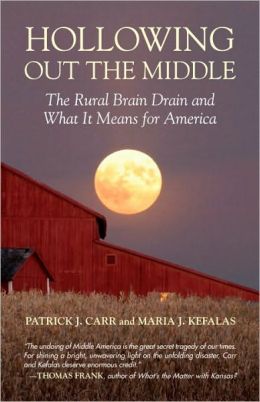Small-town America is dying, but not without help. According to Patrick Carr and Maria Kefalas, it takes effort to leave your home, and small towns are doing a fantastic job of encouraging their best and brightest to do just that.
Hollowing Out the Middle is the result of a seven-year study by Carr and Kefalas (who are husband and wife). They sought to learn who stays in small towns, who leaves, who returns, and why; to accomplish this, they moved to a small town in Iowa. After gathering data from extensive interviews, the authors put the former students of the local high school into four categories: Achievers, Stayers, Seekers, and Returners.
The Achievers were the “class valedictorians and the first chairs from the orchestra, the track stars and student-government leaders.” They were the good kids, the smart ones. From the beginning, Achievers were groomed to succeed—and to leave. Their mistakes were excused by the local police. Their teachers expected them to do well and called them out when they didn’t. They knew that to get the kind of education and career that everyone always expected of them, they had to go elsewhere.
Stayers were everything that Achievers weren’t. They didn’t do well academically and tended not to participate in afterschool programs, but “[w]hen they skipped class, no one came looking for them, and when they didn’t turn in their homework, their parents shrugged their shoulders and told them to find a job.” Many of the Stayers did so, and their grades worsened. So they quit school altogether to work in the local nursing home or at Safeguard, the nearby ambulance manufacturer. They married young and had children. What the Stayers couldn’t foresee were stagnant blue-collar wages and the outsourcing of their jobs.
The Seekers knew they wanted to leave; they just lacked any clear idea of how to go about it. Tempted by promises of travel and education, they enlisted in the Armed Forces, not realizing quite where they would travel or how useful their military education would be in the “real world.”
Lastly, there are the Returners, whom Carr and Kefalas have subdivided into Boomerangs and High Flyers. The Boomerangs, mostly women, attended nearby community colleges or vocational schools, then married their waiting fiancés. The High Flyers have earned their degrees, had successful careers, and decided to move back for personal reasons—family or the desire to rear children in a small town.
The authors’ central recommendation is that small towns must focus more on the Stayers and Boomerangs, instead of spending so much time and energy preparing the Achievers to leave and then trying to attract them back once they become High Flyers. Carr and Kefalas recommend investing in the community-college structure by increasing the number and quality of programs that will prepare Stayers for “the demands of the modern global economy, which places a premium on technical computer-based skills.” The Midwest should be retooling for a postindustrial economy, preparing its young people for the types of jobs it is trying to attract.
Overall, Hollowing Out the Middle is an insightful look at how small towns are killing themselves. The authors’ suggestions are, for the most part, useful, although their politically correct ideology is at times distracting. The most important observation in Hollowing Out the Middle deserves elaboration: “it is people’s actions that ultimately determine whether a place hollows out.” It will take more than city councils and incentive programs to bring back Middle America. It will take conscious decisions by everyone involved to sacrifice, something that this book fails to mention. Those born in small towns must decide to stay and do what they can for their homes, even when that means lower wages. Manufacturers must choose to resist when possible the pressure to globalize. Love of a place is a decision.
[Hollowing Out the Middle: The Rural Brain Drain and What It Means for America, by Patrick J. Carr and Maria J. Kefalas (Boston: Beacon Press) 256 pp., $26.95]

Leave a Reply